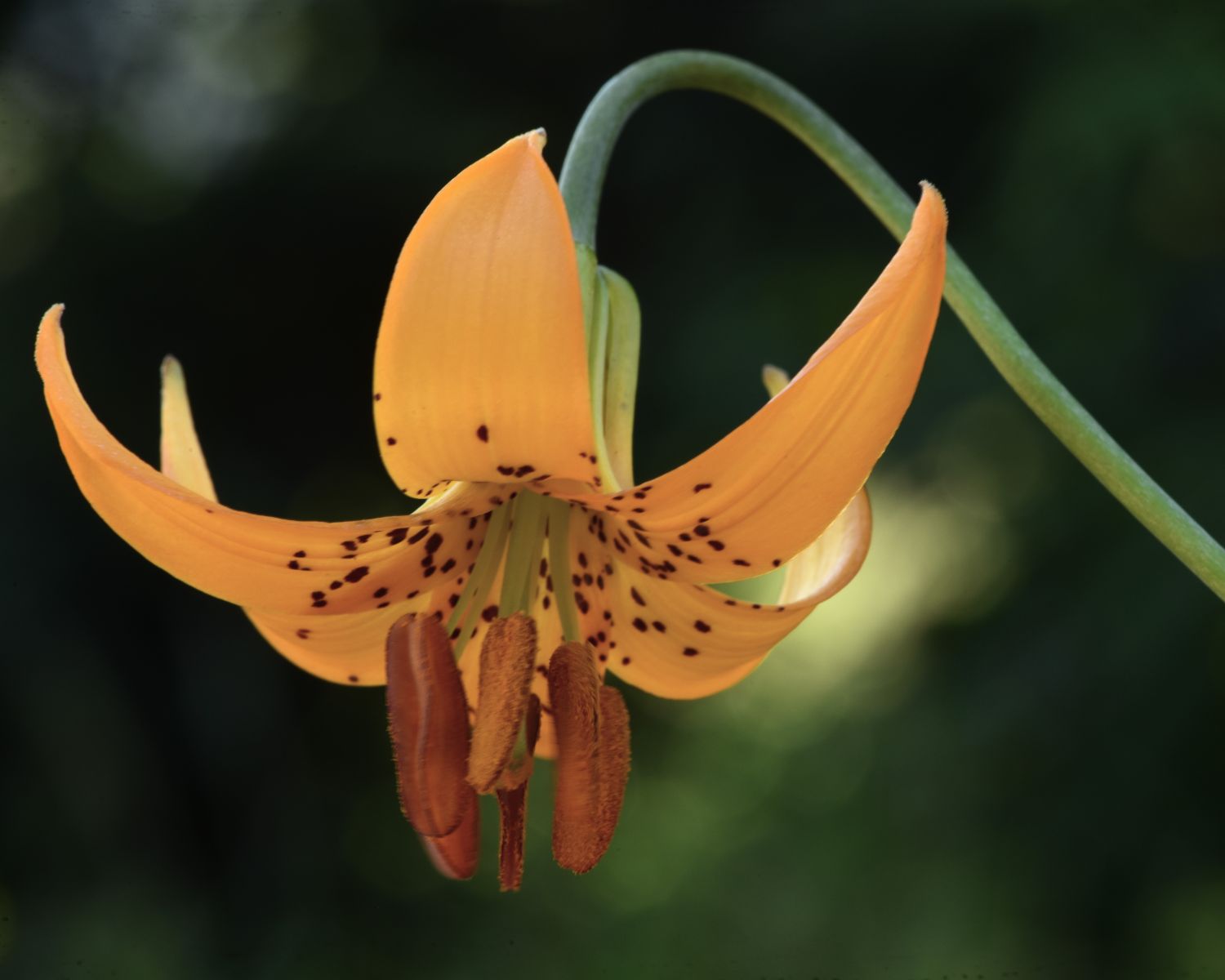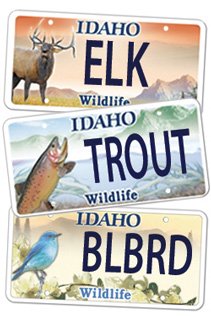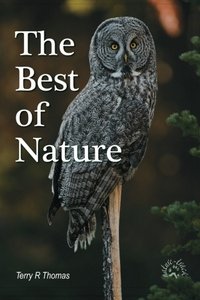Lily Family

©Terry R. Thomas/www.nature-track.com
This Columbia lily from Olympic National Park, Washington, is a member of the Lilium genus, a “true” lily.
The soils are still cold and wet from nearby melting snow when the glacier lily, also known as the dogtooth violet or yellow avalanche lily, pushes up into the sun and forms its yellow bloom. In places, this flower can form almost a carpet of blooms and is abundant enough that grizzlies and black bears will dig it up for its nutritious bulb, just as Nez Perce Native Americans did.
Glacier lilies are members of the Liliaceae family. This is a large family with 15 genera and about 610 species. It is a global family, but Central Asia seems to be the hotbed for the most species.
Members of the lily family share several characteristics. They are perennial, monocots (flowering plants whose seeds contain only one embryonic leaf, or cotyledon), petals and sepals that are similar and called tepals, have flower parts in groups of three, and usually grow from bulbs. The leaves are generally simple, often growing from the base of the plant and have veins that run parallel to the leaf edge.
Besides the glacier lily, some of the more common species of the lily family include the popular Easter lily, sego lily, fritillaria, and Oriental lilies. Lilies are wildly popular with gardeners and there are over 8,000 varieties of cultivated lilies. Of the 15 genera of this family, one of the most well-known may be the tulip genus, originally from an area stretching from southern Europe to Central Asia. From these humble beginnings, the tulip has become cultivated and naturalized worldwide.
Within the lilies is a genus that takes the family name, Lilium. This genus accounts for about 100 species and is distributed around the world largely within the temperate regions of the Northern hemisphere. However, this genus has been so popular that it is now naturalized in many areas worldwide, even Africa. There is even a group, the Lilium Species Foundation, dedicated to “growing and conserving Lilium species.”
Members of the genus Lilium often have large fragrant flowers and are known for two things from an animal standpoint. First, most are very high on every deer’s menu and because of that some species are struggling. Oddly, the number two thing about Lilum is their known high toxicity to cats.
We don’t find many members of the genus Lilium in the Intermountain West. Most North American lilies are found on the coasts and in the Central US. Location or origin is important because lilies are usually grouped by where they come from in assemblages called divisions.
You may hear the term, “true lily” and is referring to members of the genus lilium. This is to distinguish them from many other plants that have “lily” in the name, but are not members of the genus lilium or even the family Liliaceae in some cases. Some examples are, day lilies, peace lilies, water lilies, lily-of-the-valley, and canna lilies. None of these grow from bulbs as members of Lilium do.
The Liliaceae family was first described in 1763. At that time, it sort of became a dumping ground for any species of the order Liliales for which there did not seem to be a home otherwise. At its peak, Liliaceae had 300 genera and 4,500 species. It has taken 250 years to whittle the family back down to plants that are actually related.
Lilies of many types are tremendously popular for landscaping. If you pay attention to the species requirements (do they like shade or sun, rich soil, good drainage?) they are often easy to grow. Just don’t let your cat eat them.
Help Idaho Wildlife
When we traveled across the state in October 2017, we visited most of the Idaho Department of Fish and Game wildlife management areas. Most of the vehicles we saw using the wildlife management areas did not have wildlife plates. Buying wildlife plates is a great way for non-hunters and hunters alike to support wildlife-based recreation like birding.
C'mon folks, let's help Idaho's wildlife by proudly buying and displaying a wildlife license plate on each of our vehicles!
See below for information on Idaho plates. Most states have wildlife plates so if you live outside Idaho, check with your state's wildlife department or vehicle licensing division for availability of state wildlife plates where you live.
And tell them that you heard about it from Nature-track.com!

Wildlife License Plates
Great news! as of 2024, there are three NEW designs for license plates. They still are bluebird, cutthroat trout and elk, but they are beautiful.
Idaho Wildlife license plates provide essential funding that benefits the great diversity of native plants and wildlife that are not hunted, fished or trapped—over 10,000 species or 98% of Idaho’s species diversity. Game species that share the same habitats (such as elk, deer, antelope, sage-grouse, salmon, trout) also benefit from these specialty plates.
No state tax dollars are provided for wildlife diversity, conservation education and recreation programs. Neither are any revenues from the sale of hunting or fishing licenses spent on nongame species. Instead, these species depend on direct donations, federal grants, fundraising initiatives—and the Idaho Wildlife license plates.
Both my vehicles have Bluebird Plates. I prefer the bluebird because the nongame program gets 70 percent of the money from bluebird plates, but only 60 percent of the money from elk and trout plates - 10 percent of the money from elk plates supports wildlife disease monitoring and testing programs (to benefit the livestock industry) and 10 percent from cutthroat plates supports non-motorized boat access.
Incidentally, in 2014, the Idaho Legislature denied the Department of Fish and Game the ability to add new plates or even to change the name of the elk and cutthroat plates (very specific) to wildlife and fish plates, a move that would have allowed for changing images occasionally and generating more revenue. It would seem that they believe that we Idahoans don't want a well funded wildlife program.
I think it is time we let the Legislature know that Idahoan support wildlife funding and that we would like to see these generic plates come to fruition.

"WOW. What a phenomenal piece you wrote. You are amazing." Jennifer Jackson
That is embarrassing, but actually a fairly typical response to my nature essays. Since The Best of Nature is created from the very best of 16 years of these nature essays published weekly in the Idaho Falls Post Register (online readership 70,000), it is a fine read. It covers a wide variety of topics including humorous glimpses of nature, philosophy, natural history, and conservation. Readers praise the style, breadth of subject matter and my ability to communicate complex and emotional topics in a relaxed and understandable manner.
Everyone can find something to love in this book. From teenagers to octogenarians, from the coffee shop to the school room, these nature essays are widely read and enjoyed.
Some of the essays here are my personal favorites, others seemed to strike a chord with readers. Most have an important message or lesson that will resonate with you. They are written with a goal to simultaneously entertain and educate about the wonderful workings of nature. Some will make you laugh out loud and others will bring a tear to the eye and warm your heart.
Readers Write:
"You hit a home run with your article on, Big Questions in Nature. It should be required reading for everyone who has lost touch with nature...great job!" Joe Chapman
"We enjoyed your column, Bloom Where Planted. Some of the best writing yet. The Post Register is fortunate to have your weekly columns." Lou Griffin.
To read more and to order a copy, click here or get the Kindle version
Copies are also available at:
Post Register
Island Park Builders Supply (upstairs)
Barnes and Noble in Idaho Falls
Harriman State Park, Island Park
Museum of Idaho
Valley Books, Jackson Wyoming
Avocet Corner Bookstore, Bear River National Wildlife Refuge, Brigham City, Utah
Craters of the Moon National Monument Bookstore, Arco, Idaho